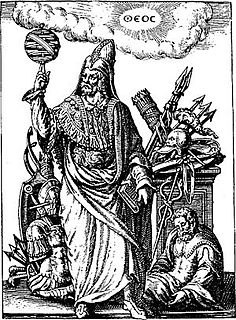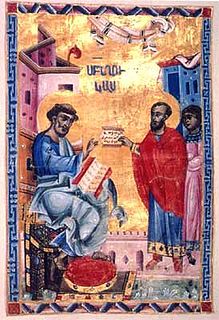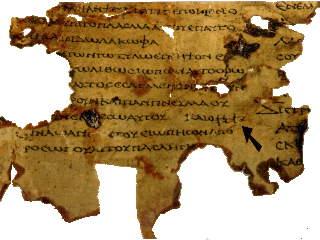Related Research Articles

The Old Testament is the first division of the Christian biblical canon, which is based primarily upon the 24 books of the Hebrew Bible or Tanakh, a collection of ancient religious Hebrew writings by the Israelites. The second division of Christian Bibles is the New Testament, written in the Koine Greek language.

The Greek Old Testament, or Septuagint, is the earliest extant Greek translation of books from the Hebrew Bible. It includes several books beyond those contained in the Masoretic text of the Hebrew Bible as canonically used in the tradition of mainstream Rabbinical Judaism. The additional books were composed in Greek, Hebrew, or Aramaic, but in most cases, only the Greek version has survived to the present. It is the oldest and most important complete translation of the Hebrew Bible made by the Jews. Some targums translating or paraphrasing the Bible into Aramaic were also made around the same time.

Hermeticism, or Hermetism, is a label used to designate a philosophical system that is primarily based on the purported teachings of Hermes Trismegistus. These teachings are contained in the various writings attributed to Hermes, which were produced over a period spanning many centuries, and may be very different in content and scope.
Clementine literature is the name given to the religious romance which purports to contain a record made by one Clement of discourses involving the Apostle Peter, together with an account of the circumstances under which Clement came to be Peter's travelling companion, and of other details of Clement's family history. The author is sometimes called Pseudo-Clement.
The Testament of Solomon is a pseudepigraphical composite text ascribed to King Solomon but not regarded as canonical scripture by Jews or Christian groups. It was written in the Greek language, based on precedents dating back to the early 1st millennium CE, but was likely not completed in any meaningful textual sense until sometime in the medieval period. In its most noteworthy recensions, the text describes how Solomon was enabled to build his temple by commanding demons by means of a magical ring that was entrusted to him by the archangel Michael.
Ariston of Pella, was an apologist and chronicler, who is known only from a mention by Eusebius that "as Aristo relates" in connection with accounts of emperor Hadrian and Simon bar Kokhba. Aristo is Eusebius's source for Hadrian's permanent banishment of Jews from Jerusalem (4.6.3), renamed to Aelia Capitolina.
"the whole nation from that time was strictly forbidden to set foot on the region about Jerusalem, by the formal decree and enactment of Adrian, who commanded that they should not even from a distance look on their native soil!" So writes Aristo of Pella." Eusebius
Aquilaof Sinope was a translator of the Hebrew Bible into Greek, a proselyte, and disciple of Rabbi Akiva.

Frederick Cornwallis Conybeare, was a British orientalist, Fellow of University College, Oxford, and Professor of Theology at the University of Oxford.
In contrast to the variety of absolute or personal names of God in the Old Testament, the New Testament uses only two, according to the International Standard Bible Encyclopaedia.

Theodotion was a Hellenistic Jewish scholar, perhaps working in Ephesus, who in c. 150 CE translated the Hebrew Bible into Greek. Whether he was revising the Septuagint, or was working from Hebrew manuscripts that represented a parallel tradition that has not survived, is debated. In the 2nd century Theodotion's text was quoted in The Shepherd of Hermas and in Justin Martyr's Dialogue with Trypho. His finished version, which filled some lacunae in the Septuagint version of the Book of Jeremiah and Book of Job, formed one column in Origen of Alexandria's Hexapla, c. 240 CE. The Hexapla, now only extant in fragments, presented six Hebrew and Greek texts side-by-side: two Greek versions, by Aquila and Symmachus, and Theodotion's version following it, apparently reflecting a contemporary understanding of their historical sequence.

Seeing Islam As Others Saw It: A Survey and Evaluation of Christian, Jewish and Zoroastrian Writings on Early Islam from the Studies in Late Antiquity and Early Islam series is a book by scholar of the Middle East Robert G. Hoyland.

The Old Testament is the first section of the two-part Christian biblical canon; the second section is the New Testament. The Old Testament includes the books of the Hebrew Bible (Tanakh) or protocanon, and in various Christian denominations also includes deuterocanonical books. Orthodox Christians, Catholics and Protestants use different canons, which differ with respect to the texts that are included in the Old Testament.

The Acts of the Apostles is a genre of Early Christian literature, recounting the lives and works of the apostles of Jesus. The Acts are important for many reasons, one of them being the concept of apostolic succession. They also provide insight into the valuation of "missionary activities among the exotic races," since some of them feature missionary work done among, for instance, the Cynocephaly.

The Dialogue with Trypho, along with the First and Second Apologies, is a second-century Christian apologetic text, usually agreed to be dated in between AD 155-160. It is seen as documenting the attempts by theologian Justin Martyr to show that Christianity is the new law for all men, and to prove from Scripture that Jesus is the Messiah.
Jewish polemics and apologetics in the Middle Ages were texts written to protect and dissuade Jewish communities from conversion to Christianity, or more rarely to Islam. The terms polemics and apologetics may be distinguished but may also be considered somewhat subjective. A smaller number of proselytizing text also exists intended to convert Christians, or more rarely Muslims, to Judaism. However, the vast majority of Jewish polemical literature was written in response to Christian polemical writings and with a permanent reference to Christian arguments.
The Dialogue of Jason and Papiscus is a lost early Christian text in Greek describing the dialogue of a converted Jew, Jason, and an Alexandrian Jew, Papiscus. The text is first mentioned, critically, in the True Account of the anti-Christian writer Celsus, and therefore would have been contemporary with the surviving, and much more famous, Dialogue between the convert from paganism Justin Martyr and Trypho the Jew.
The Dialogue of Athanasius and Zacchaeus is a 4th-century Greek Christian text giving a dialogue, akin to that of Dialogue with Trypho, between Athanasius, a Christian, and Zacchaeus, a Jew. Patrick Andrist and other scholars consider the work, however much it may have a base in real encounters, is primarily a missionary catechism.
The Dialogue of Simon and Theophilus is a 5th-century Latin Christian text giving a dialogue, akin to that of Dialogue with Trypho, between Simon, a Jew, and Theophilus, a Christian. The Altercatio is the oldest surviving Jewish-Christian dialogue preserved in Latin. It has been attributed to, and may even be by, Cyprian. The work draws on earlier Greek and Latin traditions.

The Greek Minor Prophets Scroll from Nahal Hever is a Greek manuscript of a revision of the Septuagint dated to the 1st century CE. The manuscript is kept in the Rockefeller Museum in Jerusalem. It was first published by Dominique Barthélemy in 1963. The Rahlfs-Siglum is 943.

The AqBurkitt are fragments of a palimpsest containing a portion of the Books of Kings from Aquila's translation of the Hebrew bible from the 6th century, overwritten by some liturgical poems of Rabbi Yannai dating from the 9–11th century. This Aquila translation was performed approximately in the early or mid-second century C.E.
References
- ↑ Martin C. Albl And scripture cannot be broken: the form and function of the early ... 1999 Page 122 "3.4.10 Dialogue of Timothy and Aquila - Williams had dated this dialogue to c. 200 CE, and speculated that it was probably written in Egypt.130 The most recent editor, Robert Gerald Robertson, however, concludes that the work was "
- ↑ William Varner, Ancient Jewish-Christian dialogues: Athanasius and Zacchaeus, Simon and Theophilus, Timothy and Aquila: introductions, texts, and translations E. Mellen Press, 2004 "This work provides the texts and translations of three ancient Jewish-Christian dialogues: The Dialogue of Athanasius and Zacchaeus (Greek, 4th c.); The Dialogue of Simon and Theophilus (Latin, 5th c.); and The Dialogue of Timothy and Aquila (Greek, 6th c.). This is the first published translation of each of these texts. An introduction discusses the context of these dialogues in the "Contra Judaeos" literature of the early church and also explores the question of whether or not they"
- ↑ The dialogue of Timothy and Aquila: a critical text, introduction Robert Gerald Robertson - 1986
- ↑ Exploring the scripturesque: Jewish texts and their Christian contexts - Page 173 Robert A. Kraft 2009 "CHAPTER TEN THE DIALOGUE OF TIMOTHY AND AQUILA AND ITS ECHOES OF JUDAISM Interest in this text has spawned a number of dissertations and detailed studies, ...
- ↑ F. C. Conybeare The Dialogues of Athanasius and Zacchaeus and of Timothy and Aquila, Oxford. 1898. 45. Ibid.. p. xxxiv.
- ↑ Sébastien Morlet La "démonstration évangélique" d'Eusèbe de Césarée 2009 "Dans le même temps, FC Conybeare se fit lui aussi le défenseur de l'hypothèse «Jason et Papiscus ». En 1898, il suggéra que le Dialogue de Timothée et Aquila et le Dialogue d'Athanase et Zacchée étaient deux recensions différentes d'un "